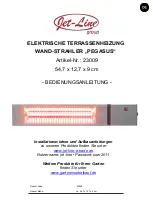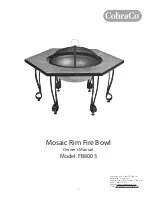
8
PREPARATION
each appliance remaining connected to the common venting system placed in operation, while the
other appliances remaining connected to the common venting system are not in operation.
a. Seal any unused openings in the common venting system.
b. Visually inspect the venting system for proper size and horizontal pitch and determine there is no
blockage or restriction, leakage, corrosion and other deficiencies which could cause an unsafe
condition.
c. Insofar as is practical, close all building doors and windows and all doors between the space in
which the appliances remaining connected to the common venting system are located and other
spaces of the building. Turn on clothes dryers and any appliance not connected to the common
venting system. Turn on any exhaust fans, such as range hoods and bathroom exhausts, so they
will operate at maximum speed. Do not operate a summer exhaust fan. Close fireplace dampers.
d. Place in operation the appliance being inspected. Follow the lighting instructions. Adjust
thermostat so appliance will operate continuously.
e. Test for spillage after 5 minutes of main burner operation. Use the flame of a match or candle, or
smoke from a cigarette, cigar, or pipe.
f.
After it has been determined that each appliance remaining connected to the common venting
system properly vents when tested as outlined herein, return doors, windows, exhaust fans,
fireplace dampers, and any other gas-burning appliance to their previous conditions of use.
g. Any improper operation of common venting system should be corrected so the installation
conforms with the National Fuel Gas Code, ANSI Z223.1 — latest edition. Correct by resizing to
approach the minimum size as determined using the appropriate tables in Table 13 of NFPA54
ANSI Z223.1 2006 of that code. Canadian installations must comply with B149.1 or B149.2
Installation Code.
H. WATER CHEMISTRY
1. Water Hardness
Water hardness is mainly due to the presence of calcium and magnesium salts dissolved in the
water. The concentration of these salts is expressed in mg/L, ppm or grains per gallon, as a
measure of relative hardness of water. Grains per gallon is the common reference measurement
used in the U.S. water heater industry. Hardness expresses as mg/L or ppm may be divided by
17.1 to convert to grains per gallon. Water may be classified as very soft, slightly hard, moderately
hard or hard based on its hardness number. The minerals in the water will precipitate out when
the water is heated and will cause accelerated lime and scale accumulation on a heat transfer
surface.
If the hardness of the water exceeds the maximum level of 25 grains per gallon, water should be
softened to a hardness level no lower than 5 grains per gallon. Water softened as low as 0 to 1
grain per gallon may be under-saturated with respect to calcium carbonate resulting in water that
is aggressive and corrosive.
2. pH of Water
pH is a measure of relative acidity, neutrality or alkalinity. Dissolved minerals and gases affect
PART 3: PREPARE WATER HEATER LOCATION
(CONTINUED)
n
CAUTION
Chemical imbalance of your water can cause severe damage to your water heater and
associated equipment and may also affect the efficiency. You may have to have your
water quality professionally analyzed to determine whether you need to install a water
softener. Failure of a heat exchanger due to lime scale build-up on the heating surface,
low pH or other chemical imbalance is non-warrantable.
Содержание Phoenix
Страница 1: ... Installation Operation Maintenance 2007 Heat Transfer Products Inc ...
Страница 31: ...30 WIRING F INTERNAL WIRING PART 6 START UP PROCEDURE CONTINUED Phoenix Connector Diagram ...
Страница 41: ...40 MAINTENANCE NOTES ...
Страница 42: ...41 MAINTENANCE NOTES ...
Страница 43: ...42 MAINTENANCE NOTES ...
Страница 44: ... 2008 2007 Heat Transfer Products Inc www htproducts com LP 179 REV 4 5 08 ...
Страница 68: ...23 ...
Страница 69: ...24 ...
Страница 73: ...28 MAINTENANCE NOTES ...
Страница 74: ...29 MAINTENANCE NOTES ...
Страница 75: ...30 MAINTENANCE NOTES ...










































